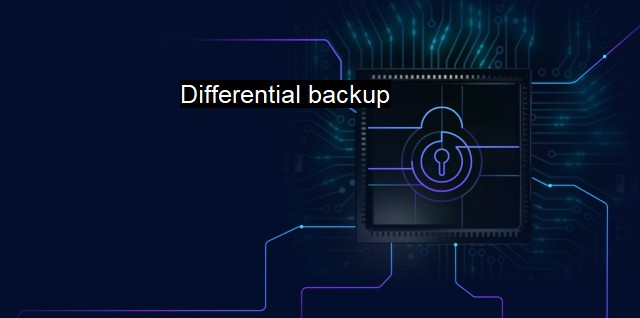What is Differential backup?
Maximizing Cybersecurity with Differential Backup: The Importance and Mechanics of an Effective Antivirus Management Tool
Differential backup is a data protection technique that revolves around the process of storing changes made since the last complete backup. the term pertains to just a segment of a broader security strategy. Yet, it is crucial for reducing data loss risk and fortifying system resilience.This kind of backup is accomplished by cataloging the differences between the current data set and the data as it stood during the last full backup. For a simplified illustration, consider this example: if a full backup of a data set is performed on Monday, then Tuesday's differential backup would only copy changes made to the Monday files. If another change occurs on Wednesday, the differential backup would then conta modifications made since the initial backup on Monday. Notably, this is a deviation from incremental backup—a methodology that catalogues each change sequentially.
Differential backups reduce the risk of data loss—particularly in relation to cybersecurity threats. One significant challenge in the digital atmosphere exists that a malicious agent, like a virus, could infiltrate the system and corrupt or completely erase vital information. A reliably stored differential backup ensures the availability of clean, uncorrupted versions of files which could be reinstated to resume normal operations rapidly.
When nefarious elements like ransomware threaten to hold data hostage, a differential backup can replace the encrypted files effortlessly and dodge the generally expensive decryption or the necessity to comply with potential ransom demands. This kind of backup reinforces an organization's data recovery strategy, thereby diminishing the potential damage from such cyber attacks.
The application of differential backup is also observed in antivirus operations. As antiviruses frequently update their threat databases, differential backups serve to augment these updates without necessitating a full backup each time. It can periodically register changes in system configurations and software versions, letting the administrators make point-in-time restores whenever needed.
Overarchingly, with differential backup processes, systems can protect against both novel viruses and known variants that could exploit software vulnerabilities. Here, the key is to facilitate a swift system restoration, helping reduce any downtime that might follow such an intrusion.
Despite these benefits, differential backups come with some drawbacks too. They require robust storage resources, given regular replication of entire datasets since the last full backup. Also, as they collect more and more data over time, the amount of time to perform these backups increases, potentially impacting system performance.
Strategies are in place to efficiently manage these operations. For instance, organizations often combine differential backups with regular full backups. In such cases, a full backup may be performed weekly with daily differentials, striking a balance between the storage requirements for the backup and restoring data efficiently if a breach does indeed occur.
Also, emerging technologies like cloud-based backup solutions are resolving limitations in terms of storage capacities. The cloud breakthrough provides virtually unlimited storage and valuable automatic backup options, while reducing the overall costs and operating commitment required for differential backups.
Differential backups provide an effective line of defense especially when used in conjunction with other methods. They reinforce the vigilance of antivirus programs, enabling rapid updates and recovery in the face of threats. Balancing differential backups with full backups and leveraging innovative storage solutions can provide a potent blend of security, resilience, and operational efficiency. Maintaining this balance is key to a comprehensive strategy for counteracting evolving cyber threats.

Differential backup FAQs
What is a differential backup and how does it help in cybersecurity?
A differential backup is a type of backup that only copies the data that has changed since the last full backup. In cybersecurity, differential backups can be used to protect against malware attacks or data breaches. By regularly creating differential backups, organizations can quickly restore their systems to a known-good state if they are compromised.How is differential backup different from incremental backup?
Differential backup and incremental backup are similar in that they both only copy the data that has changed since the last backup. However, the difference between the two is that incremental backups only copy the changes since the last backup, while differential backups copy the changes since the last full backup. This means that, over time, differential backups can become larger than incremental backups, but they are often faster to restore.Can differential backups be used with antivirus software?
Yes, differential backups can be used with antivirus software. In fact, many antivirus programs have built-in features that allow for regular backups of important files and folders. By using differential backups, organizations can quickly restore their systems to a known-good state if they are infected with a virus or malware.How often should I create differential backups for my cybersecurity strategy?
The frequency of differential backups will depend on the specific needs of your organization. However, as a general rule of thumb, it's recommended to create differential backups at least once a day or whenever significant changes are made to your system. This will help ensure that you have a recent backup in case of a cybersecurity incident.| | A | | | B | | | C | | | D | | | E | | | F | | | G | | | H | | | I | | | J | | | K | | | L | | | M | |
| | N | | | O | | | P | | | Q | | | R | | | S | | | T | | | U | | | V | | | W | | | X | | | Y | | | Z | |
| | 1 | | | 2 | | | 3 | | | 4 | | | 7 | | | 8 | | |||||||